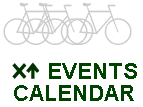A Critical Mess
The New York Times
December 5, 2004
The sight of hundreds or even thousands of bicycles on busy streets is something that sounds more like Beijing than New York, but on Manhattan’s avenues, it has become a regular event. In monthly rides meant to promote healthful and nonpolluting commuting, cyclists have gathered and then pedaled for a few blocks en masse, often up Park Avenue from a parking lot at Union Square.
The ride, called Critical Mass, is part of a grass-roots effort that has taken hold in major American cities and hundreds of other cities worldwide. In recent months, though, what for six years had been a generally uneventful spin in New York City has drawn the ire of the police, who regard the bikers as a safety and security hazard and illegal to boot. The city has asked a federal court to halt the rides unless organizers get a permit, as they would for a parade. That could bring the rides to an unfortunate end.
Some cyclists have contributed to the showdown with unnecessarily aggressive behavior like blocking traffic and running red lights. Even so, the police seem to have come on awfully strong. Other cities, among them Chicago and San Francisco, have found ways to reconcile bikers and the police. But politics and increasingly frayed tempers have complicated matters in New York.
The turning point seems to have occurred before the Republican convention last summer, when regularly scheduled rides — on the last Friday of the month — took on overtones of a political protest. In July, some cyclists headed to the F.D.R. Drive, where bike riding is not allowed. At the end of August, just before the convention, Critical Mass attracted 5,000 riders. As part of a general crackdown on protests without permits, the police detained hundreds of riders — including, apparently, innocent bystanders. Since then, scores more Critical Mass cyclists have been arrested.
Norman Siegel, a prominent civil rights lawyer who is representing five riders whose bicycles were confiscated, agrees that Critical Mass riders should obey traffic laws. But he has reasonable concerns about what the police want. By petitioning to bar future rides by groups of even a few cyclists unless they have permits, he says, the city is seeking to pre-empt Critical Mass altogether.
Critical Mass has no organizers, and there’s no way to know how many riders will participate in any given month. That’s a problem if a permit to ride must be regularly obtained. The movement — which takes its name from a documentary film about cycling — spread from San Francisco in the early 1990’s through the Internet and word of mouth. Various Web sites keep riders informed, but there is no hierarchy, and there’s no formal leader of the pack. Critical Mass by its nature is no leaders and all followers, joined together by a love of cycling.
There is no law keeping bikes off the streets. The sudden appearance of thousands of riders obviously poses a challenge, but need not inconvenience others if riders do their part and obey traffic laws as they should. There are no doubt scofflaws among Critical Mass bikers, just as there are among car drivers. But the problem now is that instead of issuing summonses, the police have been arresting the cyclists, handcuffing and taking them away. That is not the best use of New York’s finest.
In a city like New York, with heavy traffic congestion and overburdened mass transit, bicycles offer an alternative that ought to be encouraged. Bicycles do not create dangerous air emissions. They offer health benefits to the riders. And they’re easier on the city’s aging roads.
Past efforts to encourage commuter biking included the path on Sixth Avenue, a project of Mayor Ed Koch. Few people used it, many complained about it, and it was abandoned. But times are changing. As a way to promote cycling, Critical Mass has legs, in more ways than one. The city should work with riders to defuse their disagreement so the monthly rides can go on, in an orderly, lawful and safe way.

